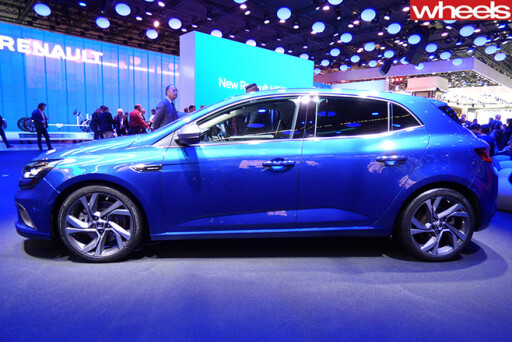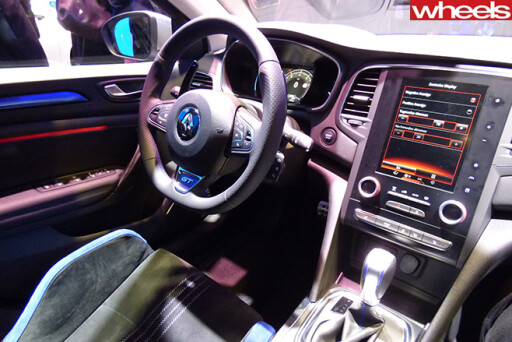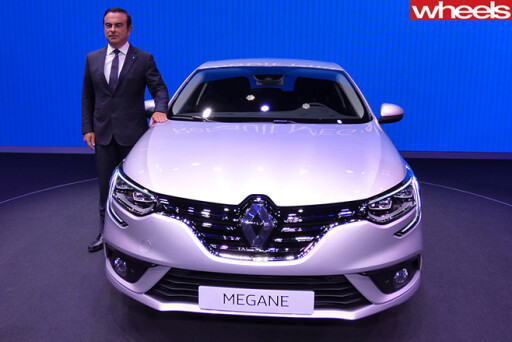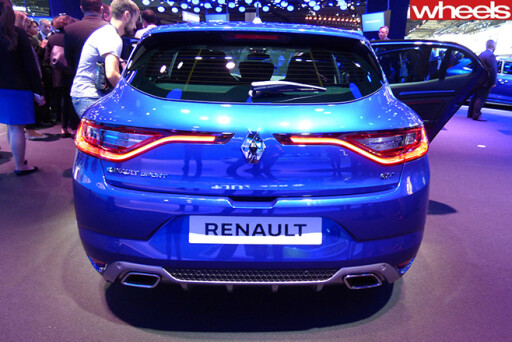
THE 2016 Renault Megane has been shown at the Frankfurt motor show and is one of the French car-maker’s most crucial products.
Yet the falling value of the Australian dollar may limit its impact here against key rivals such as the VW Golf, Peugeot 308 and Ford Focus.
The Megane will bring a raft of new features and a high-performance GT model when the line-up arrives in the second half of 2016.
You won’t mistake the new Renault Megane for the current car. Its nose has an even more prominent Renault diamond and carries a grille that links the headlamps, which feature a distinctive C-shape for instant recognition day and night.
In profile, the Megane looks a lot like a concentrated version of the Clio, which was new in 2013. The Megane will also follow its smaller sibling in being five-door only – the coupe is no more.
 There will be a wagon, which will be revealed sometime next year.
There will be a wagon, which will be revealed sometime next year.
The 2016 Megane hatch is also lower and wider than the current model, with wider front and rear tracks, a 28mm increase in wheelbase and reduced rear overhang.
That allows this car to offer greater cabin space, with more knee-room and shoulder room for rear-seat passengers, and well as a bigger boot area – up from the current 372 litres to 434 litres.
It uses the same CMF-CD platform as the Nissan Qashqai, X-Trail and Pulsar and the new Renault Espace (which is not sold here).
Tech improvements for Megane see automatic emergency braking, radar cruise-control and automatic reverse-parking, all missing from the now seven-year-old existing generation.
Infotainment includes Renault’s R-link 2, accessed via an 8.7-inch tablet screen, while there’s also a 7.0-inch TFT instrument cluster complemented by a colour head-up display.
 Engines for the Australian-market cars are yet to be confirmed. “The engine line-up updates that we’ve already seen on the existing Megane have worked really well for us, so there’s a high probability they’ll carry over,” Renault Australia CEO Justin Hocevar said.
Engines for the Australian-market cars are yet to be confirmed. “The engine line-up updates that we’ve already seen on the existing Megane have worked really well for us, so there’s a high probability they’ll carry over,” Renault Australia CEO Justin Hocevar said.
That means the excellent entry-level 1.2-litre turbo, 2.0-litre and 2.0-litre turbocharged petrol engines, and a 1.5-litre turbo-diesel. A hybrid-assist diesel will be shown in 2017, targeting 3.0L/100km fuel economy.
The GT model is currently offered only as a six-speed manual but the new Megane GT will be dual-clutch only, like the Clio RS. It will produce 152kW – a 10kW power drop over the current 2.0-litre GT. Hocevar told Wheels that the GT’s reduction in power would be made up for with better fuel efficiency, and that “the proof will be in the driving”.
The GT and GT-Line, introduced as full-time models when the current Megane was given a facelift in August 2014, have been hugely successful, as has the RS range. Australia is one of the top markets for RS models globally. Their release is yet to be confirmed but is likely late next year.
 Hocevar says that the immediate absence of a new RS model won’t leave hot hatch customers wanting.
Hocevar says that the immediate absence of a new RS model won’t leave hot hatch customers wanting.
“Certainly the sooner we get it [the new RS Megane] the better, but we do have some life within the D95 RS –the existing RS – for the next year. It’s always been a very good product in Australia; we’ve recently updated it. For the hard-core enthusiast who wants an RS with a manual and Cup chassis, we’ve got coverage.”
The new GT will benefit from one of Megane’s major technical advances, called ‘4Control’. Put simply, this is a rear-wheel steering system that works to increase agility and aid high-speed stability.
That makes it the second car at Frankfurt 2015 to debut rear-wheel steer, with the updated 991 Porsche 911 offering rear-wheel steering in its entry-level Carrera models. Rear-wheel steering has also been used in cars such as the Mitsubishi Galant VR4 and the Honda Prelude, which was Wheels Car of the Year in 1987.
The challenge for the new Megane – on top of the ongoing success of the VW Golf and Peugeot 308 – will be the exchange rate. The Aussie dollar’s weakening will affect the Megane more than many of its competitors, as the new model – like the current car – will be sourced from Palencia in Spain.
 Renault Australia has no other plants from which to source Meganes in an effort to reduce the currency disadvantage.
Renault Australia has no other plants from which to source Meganes in an effort to reduce the currency disadvantage.
Few C-segment competitors are sourced from Europe. The recently updated Ford Focus, the Toyota Corolla and the Honda Civic are all sourced from Thailand, while the Hyundai i30 five-door is made in South Korea.
Imports from these countries – both of which benefit from of a free-trade agreement with Australia – are at a clear advantage over the Megane and other European imports such as the French-made Peugeot 308 and Germany sourced Volkswagen Golf.
“Someone with a product coming out of a country with an FTA may provide an additional buffer – that is true,” concedes Hocevar. “But the Australian dollar is down against most currencies now … at the end of the day if it remains like this, it’s going to catch up.”
Despite this, Hocevar says that the C-segment is still lucrative, and that it’s worth bringing the Megane – its third-best selling model here – to Aussie showrooms. “It is the biggest segment, yes, and it has good potential. Clio has a bit of a head start … [but] it had more favourable currency.”
The Megane will cost more than its predecessor, which starts at $20,990 for the Authentique hatch and spans to $61,990 for the flagship Renault Megane RS275 Trophy-R model.
“All things being equal in currency, there would have been an organic rise in price,” Hocevar said. “The question will be whether the foreign-exchange will have a greater impact.”

COMMENTS